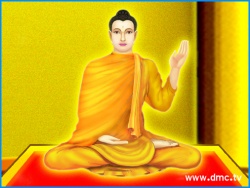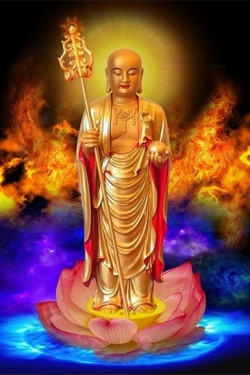Mikkyo(Esoteric Buddhism) and Shingon Buddhism
What is “Mikkyo”? Mikkyo is the Japanese word for Esoteric Buddhism and is often translated as “secret teachings”. The doctrines of Mikkyo are taught through masters of Mikkyo and the information or knowledge is transmitted spiritually according to the abilities of the practitioners. In contrast to Exoteric Buddhism (Mahayana Buddhism), in which the doctrines are taught through the use of textbooks, Mikkyo emphasizes that teaching through experience is the way to attain enlightenment. Another difference is that Exoteric Buddhism is typically taught in a large group setting and Mikkyo is usually taught person to person. The doctrines of Mikkyo have been transmitted and passed down through the lineage of the Esoteric Buddhism masters.
Esoteric Buddhism (Mikkyo) was first established in India around the 1st century during the last period of the development of Buddhism. At that time, Indian Buddhism was persecuted by followers of Hindu. Some historians point out that Indian Buddhism tried to regain its popularity by incorporating magic rituals similar to the rituals used in the Hindu religion. In fact, the original form of the Goma Fire Ritual (Homa) used in Mikkyo, came from Hindu. Magic rituals were one of the important components during the early development of Esoteric Buddhism. During this time period the followers were likely to chant mantras and dharani (陀羅尼) to wish for material goods or fortunes as opposed to spiritual well being or the desire to attain enlightenment. Over the course of time, the doctrines and practice of Buddhism became more clearly defined.
In the early stages of Buddhism it was prohibited to worship an idol or image. Furthermore, it was considered impossible to create an image that would capture the greatness of Buddha. Eventually, however, religious people began to seek a ground for their faith and create Buddhist images as their objects of worship. As the doctrines were manifested, more and more statues, pictures and figures were produced.
In Mikkyo the main images are the Five Buddhas of Wisdom with Dainichi Nyorai (Mahavairocana) as the central Buddha. These Five Buddhas of Wisdom can often be found in mandala replications. Over time, a multitude of Buddhas were created with an equally diverse range of characteristics. Each image has its own special sacred connections and powers to heal followers. In Shingon Buddhism, visual images are used to help facilitate spiritual practice. Mudras, mantras and mandalas are a necessary part of developing spiritual training. These three keys are essential to leading followers toward the potential of attaining enlightenment.
While the theories and doctrines of Esoteric Buddhism were continuing to further develop, Kobo Daishi crossed the ocean to China seeking to advance his own understanding of Buddhism. Kobo Daishi was fortunate to visit the Qing-long Temple and was taught under the guidance of Master Huiguo, a patriarch of Esoteric Buddhism. After being initiated as the eighth master of Esoteric Buddhism, Kobo Daishi returned to Japan and was given permission by the Japanese court to establish a monastery in Koyasan for the practice of meditation and teachings of Esoteric Buddhism. Kobo Daishi founded a new branch of Esoteric Buddhism known as Shingon with two main pillars in his teaching; 1, that everyone has the ability to attain enlightenment in this very lifetime (Sokushin Jobutsu); and 2, to bring eternal peace to the country of Japan.
What does it mean to attain enlightenment in this very life? “ Sokushin Jobutsu” is the Japanese term for becoming a Buddha in this very physical body. This term is one of the main theories of Shingon Buddhism and distinguishes it from the other branches. Other doctrines of Buddhism require endless efforts over many lifetimes in order to attain enlightenment. Moreover, it is necessary to be reborn again and again in order to attain enlightenment. On the contrary, the teachings of Shingon Mikkyo preach that followers have the ability to become a Buddha in this real body in this life. Kobo Daishi teaches that it is possible for anyone to attain enlightenment. Worldly desires often prevent people from realizing this ability to achieve Buddha-hood, and although it is up to the abilities of the individual practitioner to find their own way, the potential exists for everyone. Shingon Mikkyo teaches that we all have the ability to be free from concerns and isolate ourselves from any trouble by achieving enlightenment in this very life.

